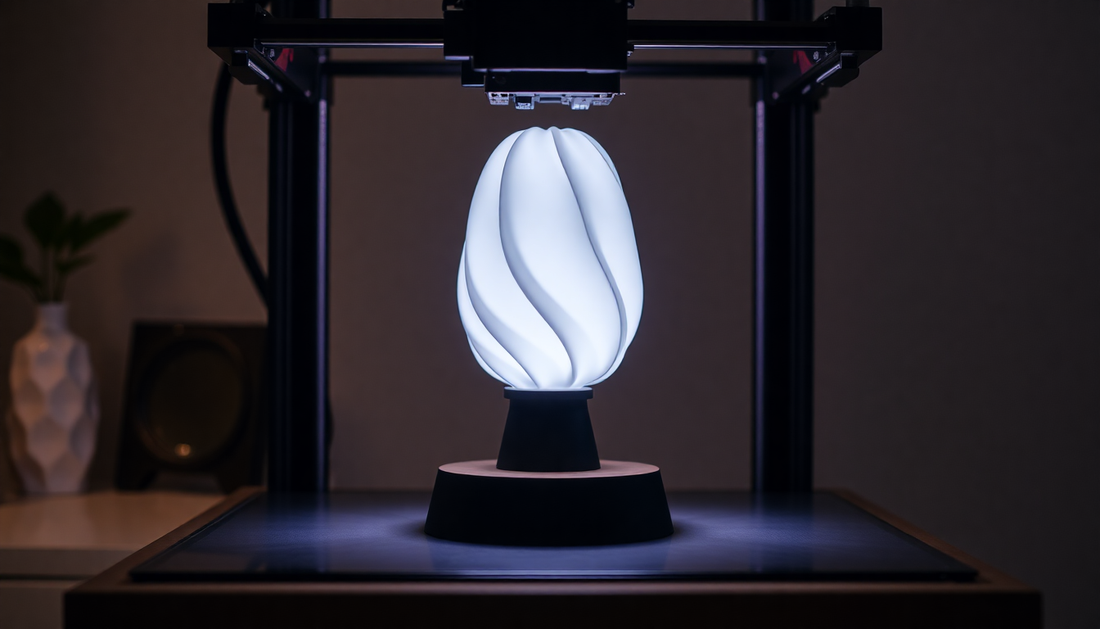
How 3D Printed Eco-Friendly Lamps Are Made
Share
Behind the Scenes: How 3D Printed Eco-Friendly Lamps Are Made
3D printed lamps are gaining popularity as people seek unique lighting solutions that also reflect their values. In an age where sustainability is paramount, using eco-friendly materials in lamp production is not just an option; it's essential. This blog takes you behind the scenes to uncover how 3D printed lamps made from eco-friendly plastic are designed, produced, and brought to your home.
What is a 3D Printed Lamp?
A 3D printed lamp is a lighting fixture created through additive manufacturing technology. This process involves layering material to build the lamp’s structure from the ground up. Unlike traditional methods that often use molds and require significant amounts of material, 3D printing allows for more creative freedom and precision while minimizing waste.
The Design Process of 3D Lamps
Creating a unique and functional lamp involves a multi-step design process. This process includes conceptualization, prototyping, and finalization.
Conceptualization
During the conceptualization phase, designers focus on aesthetics and functionality. They explore various styles and shapes, allowing creativity to flourish. The aim is to create a lamp that not only illuminates a space but also adds to the decor. Designers choose colors, textures, and forms that resonate with potential buyers, ensuring they meet market demands and personal tastes.
Prototyping
Once the concept is solidified, the prototyping stage takes place. Designers create initial models to visualize the lamp in 3D. This involves several steps: sketching, 3D modeling, and printing the first version of the lamp. Feedback is vital at this stage; testing helps assess the lamp's look and functionality. This iterative process means refining and improving designs, ensuring they are perfect for production.
Finalization
In the finalization stage, the design is prepared for actual printing. Software tools like CAD (Computer-Aided Design) are essential in this phase for detailing specifications and dimensions. Designers make final adjustments, ensuring everything is set for a successful print with 3D printed lamp using eco-friendly plastic.
Sustainable Materials for 3D Printing
Types of Eco-Friendly Plastics
A wide array of eco-friendly plastics are available for 3D printing, including PLA (polylactic acid) and PETG (glycol-modified polyethylene terephthalate). These materials are derived from renewable resources like corn starch, making them more sustainable compared to traditional plastics. Unlike petroleum-based plastics, eco-friendly options break down more easily in landfills, significantly reducing their environmental impact.
Sourcing Materials
Sourcing these sustainable materials is essential for the 3D printing process. Eco-friendly plastics can be found from various suppliers who focus on sustainable practices. Supporting these suppliers promotes a responsible industry where environmental considerations are prioritized. By choosing the right sources, we can ensure that our lamps are truly eco-friendly from start to finish.
Recycling in 3D Printing
Closed Loop System
Recycling plays a crucial role in 3D printing. Many manufacturers use a closed loop system, where waste materials from the printing process, like filament trimmings, are collected and recycled. This means less waste ends up in landfills, and new products can be made from recycled materials. The closed loop system minimizes environmental damage while maximizing resource efficiency.
Repurposing Waste
Additionally, there are innovative approaches to repurposing waste from the printing process. For example, some companies find creative ways to utilize leftover materials in other products. This not only reduces waste but also showcases the versatility of 3D printing.
Benefits of 3D Printing for Eco-Friendly Products
Reduced Waste
One of the key benefits of 3D printing is reduced waste. Traditional manufacturing often results in excess materials that go to waste. In contrast, 3D printing allows for precise use of materials, minimizing scraps and leftover pieces. This reduction directly benefits the environment, resulting in a lower carbon footprint.
Customization and Flexibility
Customization is another advantage of 3D printing. Designers can create unique, tailored designs that meet individual consumer needs. Whether it's a size adjustment for a specific room or a variation in color, 3D printing offers unmatched flexibility that traditional methods simply cannot provide. This personalized touch boosts consumer satisfaction.
Cost-Efficiency
Cost-efficiency is vital for businesses today. While initial investments in 3D printing equipment may seem high, over time, the reduction in material waste and labor costs leads to significant savings. For businesses producing 3D printed lamps, eco-friendly plastics often prove to be a cost-effective solution, offering a competitive edge in the market.
Environmentally Friendly Home Decor
The Role of 3D Printed Lamps
3D printed lamps play a significant role in environmentally friendly home decor. They provide unique design options that fit seamlessly into sustainable lifestyle choices. With diverse styles ranging from elegant to modern, eco-conscious consumers can find lamps that represent their values while enhancing their home’s aesthetic.
Trends in Sustainable Decor
Currently, sustainable decor is more than just a trend; it’s a movement. Consumers are increasingly drawn to products that align with their environmental beliefs. Eco-friendly home decor items, like 3D printed lamps, reflect a growing interest in reducing one's carbon footprint. With many options available, people are more willing to invest in sustainable choices for their homes.
Conclusion
In summary, 3D printed eco-friendly lamps represent a significant advancement in sustainable design and manufacturing. By understanding the intricate processes behind their creation, we can appreciate the benefits they offer not only to our homes but also to the environment. By choosing products made from eco-friendly materials, we actively participate in shaping a more sustainable future. Let's embrace the movement towards environmentally friendly home decor and make conscious choices in our everyday lives!
